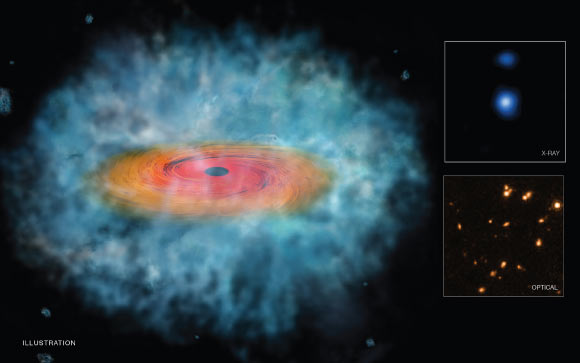Using data from three of NASA’s space observatories — the Hubble Space Telescope, Chandra X-ray Observatory, and Spitzer Space Telescope, astronomers have found the best evidence to date that supermassive black holes in the early Universe were produced by the direct collapse of a gas cloud.

This illustration represents the best evidence to date that the direct collapse of a gas cloud produced supermassive black holes in the early Universe. Researchers combined data from NASA’s Chandra, Hubble, and Spitzer telescopes to make this discovery. The inset boxes contain Chandra (top) and Hubble (bottom) images of one of two candidate seeds, where the properties in the data matched those predicted by sophisticated models produced by astronomers of the direct-collapse mechanism. Image credit: NASA / CXC / STScI.
For years scientists have debated how the earliest generation of supermassive black holes formed very quickly, relatively speaking, after the Big Bang.
Now, a team of astronomers from Italy and Japan has identified two objects in the early Universe that seem to be the origin of these early supermassive black holes.
These two objects represent the most promising black hole ‘seed’ candidates found so far.
The team, led by Dr. Fabio Pacucci from the Scuola Normale Superiore in Pisa, used computer models of black hole seeds combined with a new method to select candidates for these objects from long-exposure images from three of NASA’s space telescopes.
By analyzing the combined light from the telescopes, the scientists were able to search through thousands of objects to look for any that had properties that matched those predicted by their models.
The two candidates emerged that had the expected red color, seen by Hubble and Spitzer, as well as the X-ray profile predicted from Chandra. These objects were found in the Cosmic Assembly Near-infrared Deep Extragalactic Legacy Survey and the Great Observatories Origins Deep Survey-South surveys.
Both of these black hole seeds have an initial mass of about 100,000 times the Sun. They are so distant that they may have formed less than one billion years after the Big Bang.
According to astronomers, there are two main theories to explain the formation of supermassive black holes in the early Universe.
One assumes that the seeds grow out of black holes with a mass about ten to a hundred times greater than our Sun, as expected for the collapse of a massive star. The black hole seeds then grew through mergers with other small black holes and by pulling in gas from their surroundings.
However, they would have to grow at an unusually high rate to reach the mass of supermassive black holes already discovered in the billion years young Universe.
The new findings, published in the Monthly Notices of the Royal Astronomical Society (arXiv.org preprint), support another scenario where at least some very massive black hole seeds with 100,000 solar masses formed directly when a massive cloud of gas collapses. In this case the growth of the black holes would be jump started, and would proceed more quickly.
“Black hole seeds are extremely hard to find and confirming their detection is very difficult,” said co-author Dr. Andrea Grazian, from the National Institute for Astrophysics in Italy.
“However, we think our research has uncovered the two best candidates so far.”
“There is a lot of controversy over which path these black holes take. Our work suggests we are converging on one answer, where black holes start big and grow at the normal rate, rather than starting small and growing at a very fast rate,” said co-author Dr. Andrea Ferrara, also from the Scuola Normale Superiore.
“Our discovery, if confirmed, explains how these monster black holes were born. We found evidence that supermassive black hole seeds can form directly from the collapse of a giant gas cloud, skipping any intermediate steps,” Dr. Pacucci said.
_____
Fabio Pacucci et al. 2016. First identification of direct collapse black hole candidates in the early Universe in CANDELS/GOODS-S. MNRAS 459 (2): 1432-1439; doi: 10.1093/mnras/stw725







